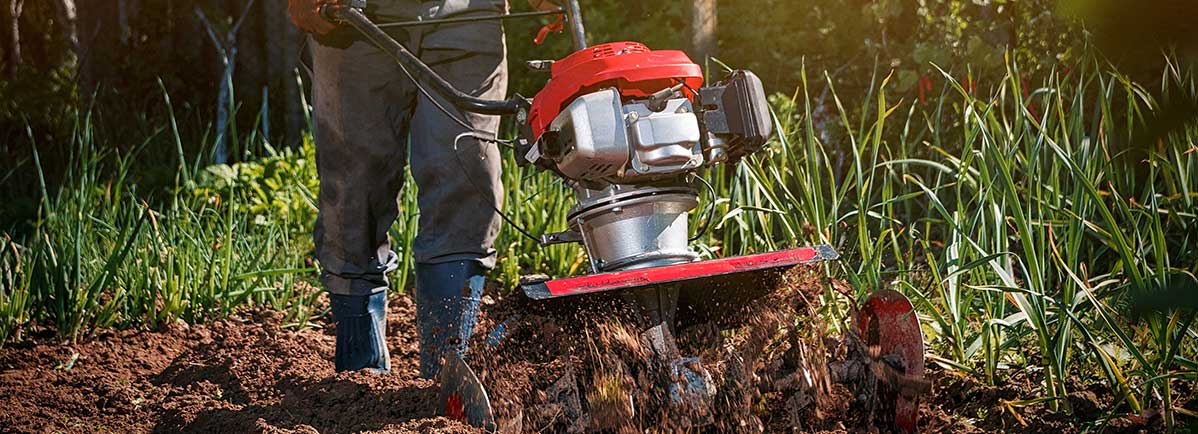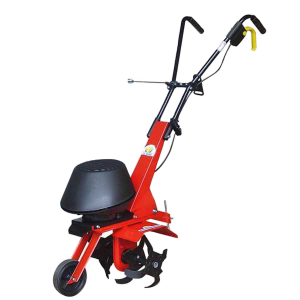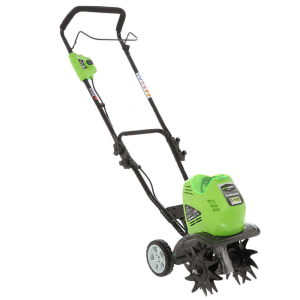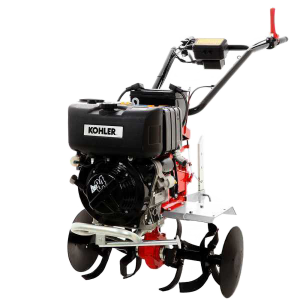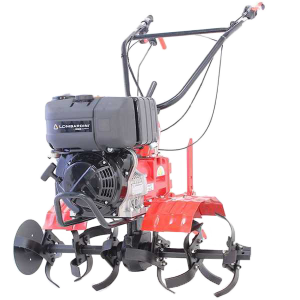A comprehensive guide to purchasing the best tiller, with lots of useful tips and explanations on how best to use it.
The Complete Guide to help you choose the Best Garden Tiller
by the Real Experts of Equipment for Soil Tilling and Care
Anyone who owns a small piece of land (such as a vegetable patch or a garden) knows how tiresome it is to prepare the surface for new plants and seeds or to remove obstacles, such as roots, and soften the soil.
In the past, spades and hoes were used to till and prepare the soil before sowing, which was a long and tiring job; today, much of this fatigue can be saved by using a garden tiller.
The garden tiller performs the milling work, digging into the top layer of soil and transforming it into small, turned over, stratified clods. Milling by breaking up the upper crust of the soil makes it finely crushed and well scarified, ready for future cropping.
CONTENTS
- 1. How the garden tiller works
- 2. Different types
- 3. The robustness of the garden tiller
- 4. Electric garden tillers
- 5. Battery-powered garden tillers
- 6. Engine-powered garden tillers
- 7. The importance of the transmission
- 8. The gears
- 9. The tillers
- 10. The engine
- 11. Garden tiller vs two-wheel tractor
1. How the garden tiller works
The movement of the garden tiller is generated by the tillers, i.e. an axle shaft connected to the engine on which “tines” (or rotary hoes) are attached.
The tines rotate deep into the soil and allow the machine to move forward and break up clods, turning over the soil and the roots.
The garden tiller is operated by means of a handlebar – consisting of a pair of handles – on which the control levers are located.
2. Different types
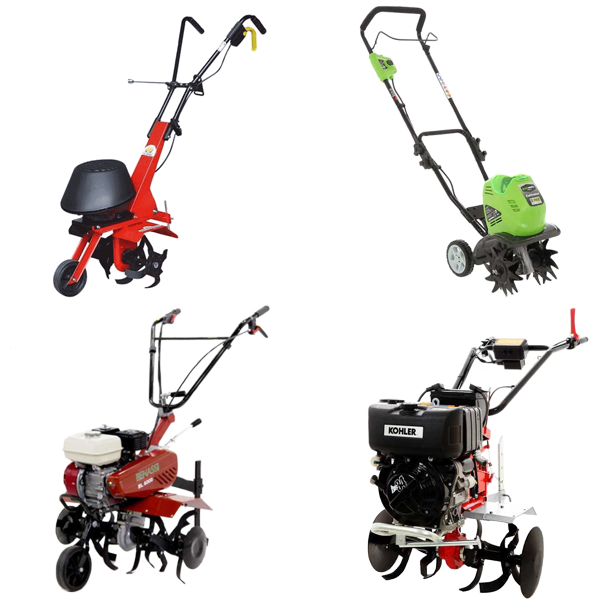
The main characteristic of a garden tiller is the type of power supply:
- Electric
- Battery-powered
- Engine-powered
– Petrol
– Diesel
We will go into each type in more detail in the next sections. For now, we would just like to point out that, while electric or battery-powered garden tillers are the most affordable choice, this is at the expense of their performance, which is certainly limited (they can only work on soft ground or carry out minor maintenance in the garden/vegetable patch).
The question about electric or battery-powered tools may be valid for garden tillers, but not for other types of products (such as brush cutters or lawn mowers), which, even if they are powered by an electric motor or battery, are still very good products that can provide excellent performance.
Therefore, if you are faced with a major milling job that requires the use of a sturdy, consistent and reliable tool, our advice is definitely to choose a petrol or diesel garden tiller.
In the next chapter we will see that one of the most important features of petrol garden tillers is their robustness.
3. The robustness of the garden tiller
To be truly versatile, a garden tiller must be robust.
The robustness of a garden tiller is directly related – in addition to its weight (kg) – to the power of the engine (in terms of number of horsepower and displacement) and the width of the tiller: the greater these components are, the easier it is to penetrate the ground and work, without the need for the operator to make an excessive effort.
A light garden tiller does not make the operator’s job any easier.
An implement that is too light is at the same time unsteady, and the lack of force and pressure of the machine – necessary to successfully dig into the ground and get a good milling job done – must inevitably be balanced out by the physical effort of the operator.
So the smaller and lighter the machine, the more fatigue the operator will bear.
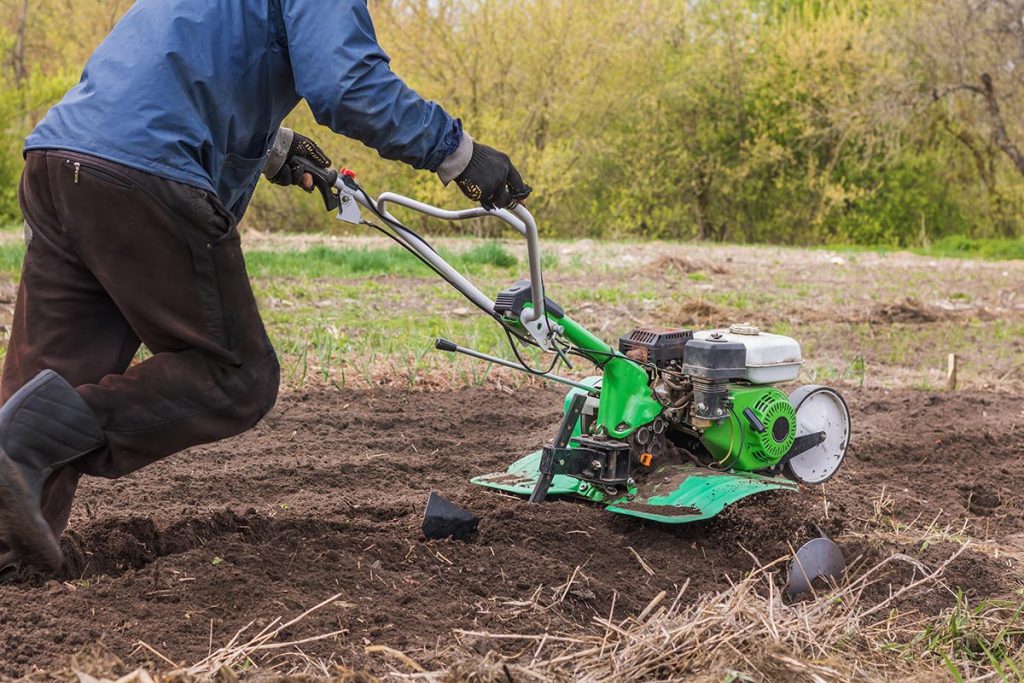
A heavy garden tiller, on the other hand, penetrates the soil more easily and works better, as it can dig deeper into the ground. An ideal garden tiller is one that can move on its own and does not need to be pushed by the operator.
4. Electric garden tillers
Electric garden tillers (also known as electric tillers) are suitable for small-scale milling work on soft, fairly limited land that has already been tilled and cleared.
They certainly have the advantage of being equipped with a very compact tiller, which makes it possible to work on small areas where other types of garden tillers cannot operate (such as flower beds, planting areas, etc.). Moreover, as already mentioned, they are very affordable (on the market there are models priced under €100).
As far as the power supply is concerned, while it is a fact that they do not need any kind of fuel, it is also true that the possible problems associated with the use of the power cable must be taken into account: in addition to a nearby electrical outlet, the cable itself could get in the way of the operator or be caught in the tiller.
5. Battery-powered garden tillers
Battery-powered garden tillers are very similar to electric garden tillers in terms of type of use (although they are on average more expensive) and should therefore be considered as equipment for limited or hobby use only.
They do not require any connection to a power outlet or any kind of fuel, as they are powered by one or more rechargeable lithium-ion batteries. They do not therefore require the typical maintenance carried out on petrol engines, such as oil change, filters cleaning, spark plugs checks, etc.
Battery-powered garden tillers are indeed a “green” solution with zero emissions; they also generate less vibration and are more silent than other types fitted with petrol engines. To make sure you are purchasing a product that suits your needs, you need to assess two important factors about the battery: its power (which depends on the voltage) and its autonomy in terms of the running time it can provide (which depends on the amperage).
As for both electric and battery-powered garden tillers, we would like to stress that a light and less-expensive product should not create false (or exaggerated) expectations in terms of use and performance.
6. Engine-powered garden tillers
Engine-powered petrol garden tillers are the most suitable product category for carrying out major milling work. To date, petrol garden tillers are the most widely used, although diesel garden tillers are more fuel-efficient and have a longer service life. For this reason, those looking for a professional garden tiller tend to move towards a diesel model, preferably a heavy series model.
Engine-powered garden tillers (whether petrol or diesel) are undoubtedly the most powerful; their power is a direct expression of the combination of a number of elements such as:
- the number of horsepower (hp)
- the engine cubic capacity (cm3/ cc)
- the transmission type (preferably with gears, as we will see later)
- the robustness
More power almost always results in greater comfort/ease of use and higher performance.
Compared to electric or battery-powered models, however, engine-powered garden tillers require some maintenance (such as spark plugs replacement, filters cleaning, oil change, etc.).
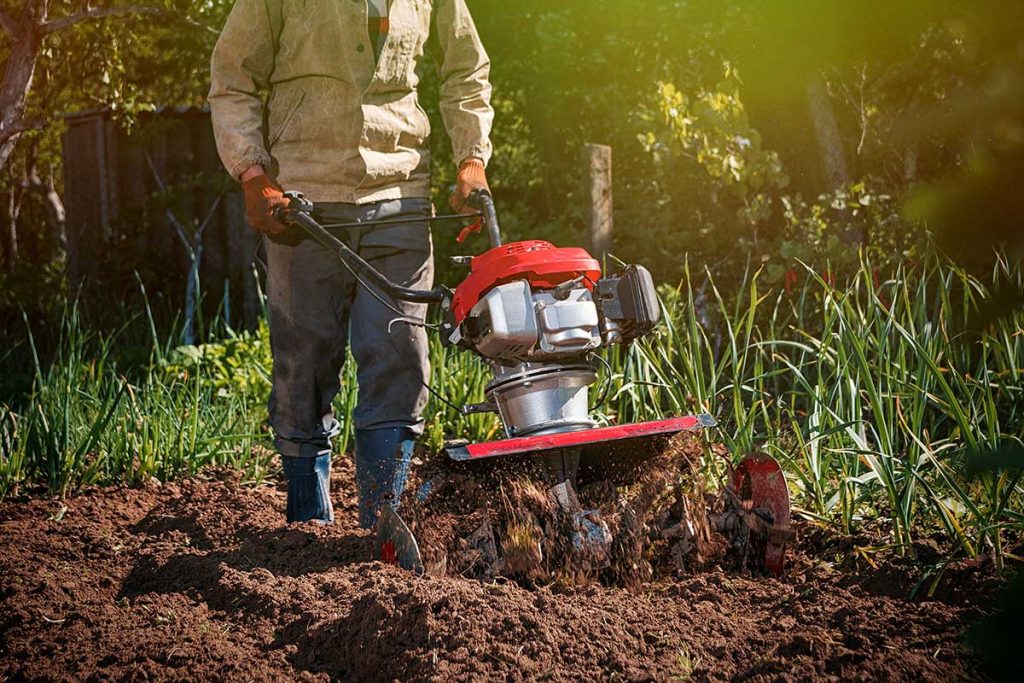
6.1 Petrol garden tillers
As already mentioned, petrol garden tillers are the most popular type on the market. The vast majority are all equipped 4-stroke engines (2-stroke engines are slowly disappearing from the market due to poor durability and lower power) and, depending on their characteristics, can be suitable for working on more or less extensive and more or less tilled land.
All types of petrol garden tillers are available, both in terms of robustness (light, medium and heavy series) and size (from very small to large).
Depending on the characteristics sought, a petrol garden tiller can be an excellent choice both for hobby users (i.e. those with rather limited needs) and for those looking for a more professional machine.
The following combinations of transmission and gearbox can usually be found:
- Small/light series➡ Belt drive | 1-speed forward gear only
- Medium series➡ Belt or gear transmission | 1 or 2-speed gear (+ reverse gear)
- Heavy series➡ Gear transmission in oil bath | 2 or 3-speed gear (+ reverse gear)
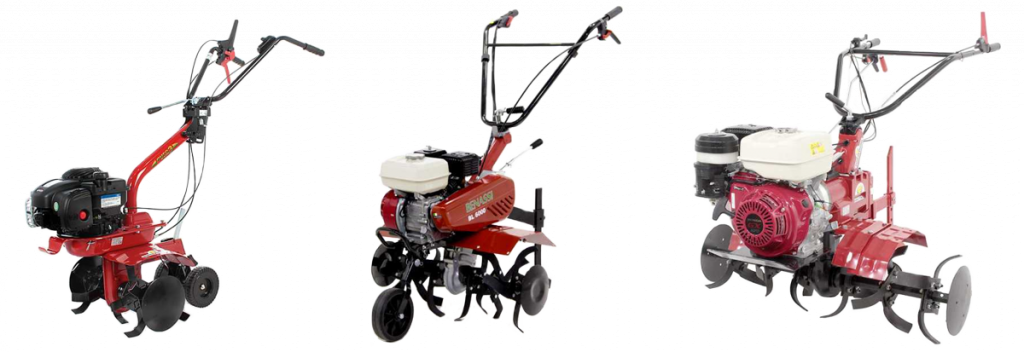
The heavy series models deserve a special mention: all of them are equipped with an gear transmission in oil bath – undoubtedly the best possible – and are particularly suitable for professional milling work, even on hard, unploughed soil.
However, we will address the subject of transmission and gears in later sections.
6.2 Diesel garden tillers
Diesel garden tillers are generally heavy series models with a gear transmission in oil bath (for which the same advantages as mentioned in the previous paragraph apply) and belong rightfully in the category of heavy-duty garden tillers.
Generally, the diesel engine is a suitable choice for those who need a machine that is expected to last despite fairly heavy use, and for those looking for a working tool that is always ready for use, even after long periods of non-use. Among the many advantages of this type of engine it should also be considered its lower consumption compared to a petrol engine.
The diesel garden tiller is a necessary choice for anyone who has to carry out heavy-duty work, even on extensive, hard, unploughed land, and for anyone who wants to make a purchase that focuses on quality, sturdiness and durability.
7. The importance of the transmission
The type of transmission of a garden tiller (i.e. the technology for transferring the power generated by the engine to the tiller) is a distinctive element of the level of the machine (hobby or professional). The transmission can be belt or gear-driven.
7.1 Belt drive
The belt drive is only found on small/light series garden tillers and withstands a low to medium level of use. There are several belt drive combinations, in which the type of transmission from the engine to the central machine body is always belt-driven, while that from the machine body to the tillers varies:
- belt and worm drive
- belt-driven and chain-driven
- belt-driven and with gears
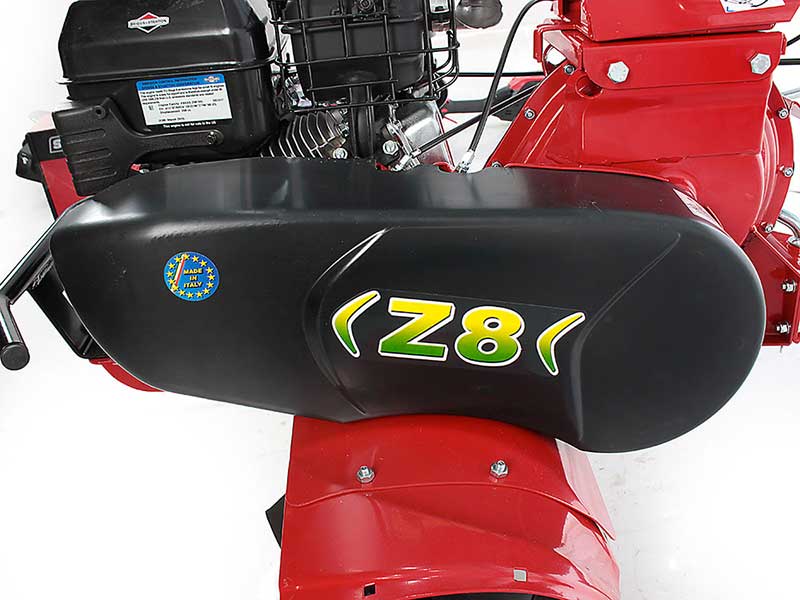
Side belt transmission 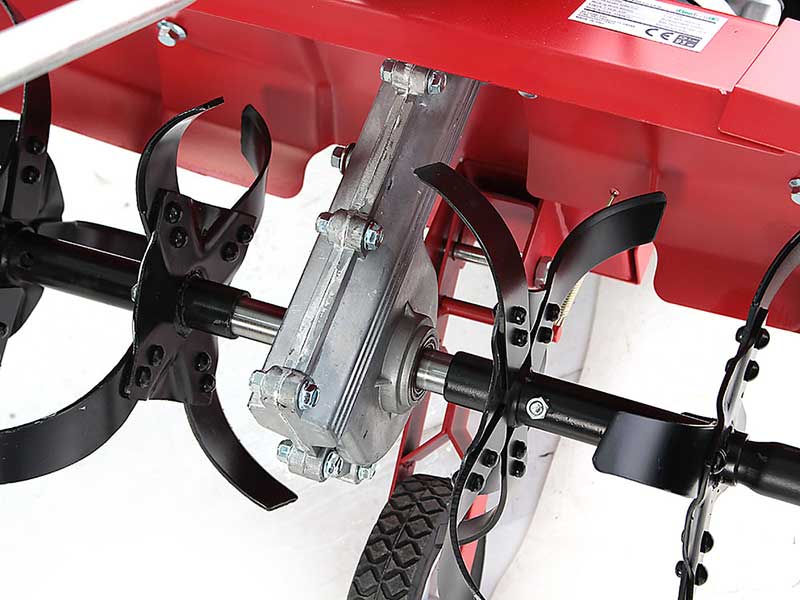
Worm drive 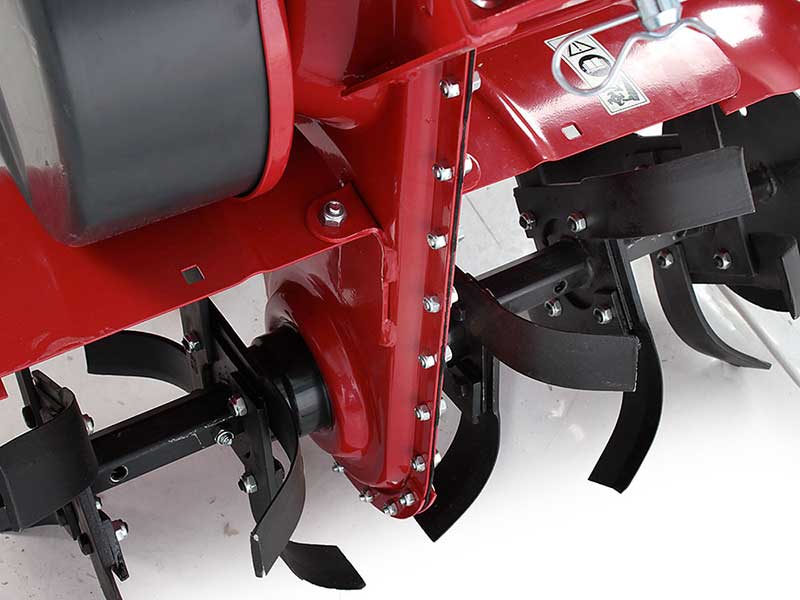
Chain transmission in oil bath
7.2 Gear transmission in oil bath
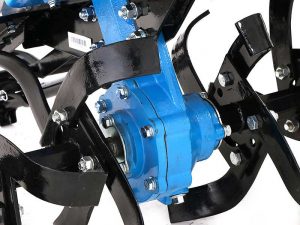
As already pointed out, the gear transmission in oil bath is by far the most robust and is universally acknowledged as the best for a garden tiller.
It is the most traditional type of transmission, but at the same time the most solid and the most well-structured.
It withstands long working sessions even on the toughest and less (or never) tilled soils and constitutes a distinctive feature of heavy-duty garden tillers.
8. The gears
The number of gears in a garden tiller gearbox determines its versatility and power.
Small garden tillers are usually single-speed (i.e. have only one forward gear), whereas larger, more structured garden tillers can come with up to 3 forward gears + 1 reverse gear.
In the following chart we provide a better overview of the various combinations that exist, taking into account the size of the garden tiller, the number of gears and the type of transmission:
| GARDEN TILLERS SIZE | GEARS | TRANSMISSION |
| small | 1 forward gear | belt-driven |
| medium/small | 1 forward gear + 1 reverse gear | belt-driven |
| medium | 2 forward gears + 1 reverse gear | belt-driven/ with gears |
| large | 3 forward gears + 1 reverse gear | with gears |
9. The tillers
The number of tillers determines the working width of the machine, while their diameter determines the depth the garden tiller can reach.
Smaller width tillers (less than 40-50 cm) allow you to pass fairly easily between rows and work in hard-to-access areas, while larger width tillers (up to 100 cm) allow you to effectively work a larger area in a single pass.

The tillers may vary according to:
- the number of tines ➡ are generally 2 or 3 per side and, if the overall width is to be reduced, the outer ones can be removed;
- consistency ➡ this depends on the type of gearbox/transmission fitted and the robustness degree of the machine; the stronger the transmission and/or the heavier the machine, the greater the consistency and therefore the effectiveness of the tillers.
There are also more professional tillers – generally mounted on medium and heavy machines equipped with gear transmission, hexagonal tubular central axis (and not a round one as in belt-driven machines): this type of tillers is certainly the most solid and robust (and long-lasting) solution possible.
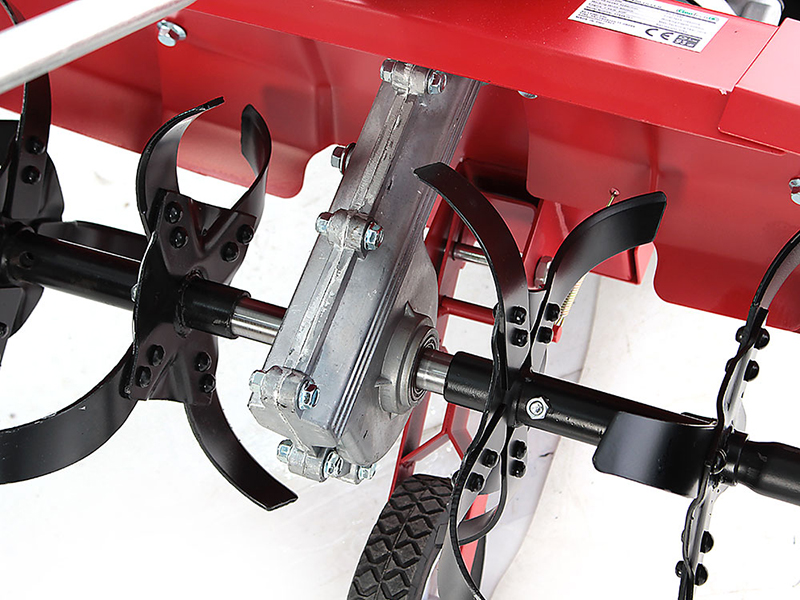
Round tubular 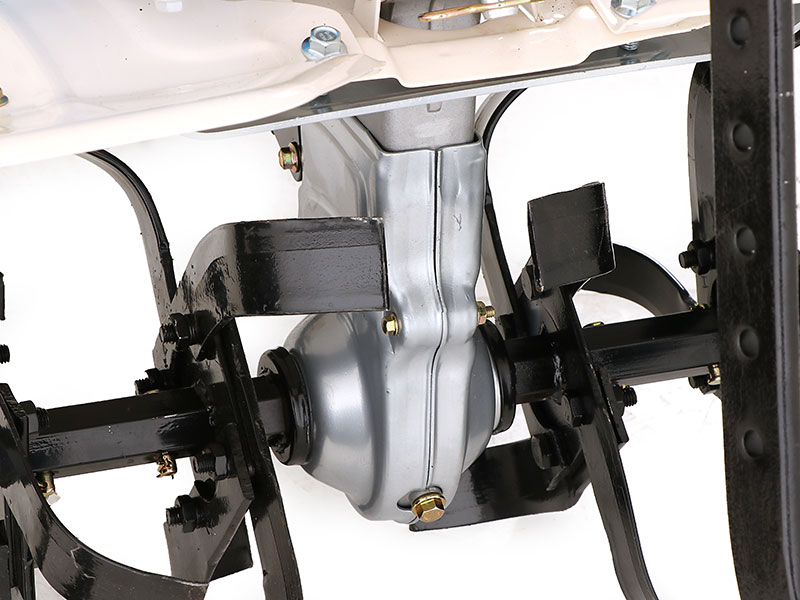
Hexagonal tubular
10. The engine
All the best heavy-duty garden tillers are equipped with an engine manufactured by globally renowned brands such as Honda, Briggs&Stratton, Lombardini, etc. The main advantage of a garden tiller that mounts a quality engine is undoubtedly its reliability.
When, on the other hand, we are confronted with (re) branded engines that bear the name of the same machine manufacturer (such as McCulloch, Hyundai, etc.), we must be aware that they are Chinese engines, i.e. low-cost engines that must all be placed on the same level.
But let’s take a brief look at which are the best engines for a garden tiller:
- Honda
The engines by Honda (undoubtedly one of the best known Japanese manufacturers) represents an absolute reference in terms of quality and reliability, and guarantee high performance on medium and heavy series petrol garden tillers, even better if combined with a Made in Italy gearbox.
- Briggs&Stratton
Briggs&Stratton engines are made in the USA and ensure optimal and long-lasting operation. They are mainly fitted on small and medium series petrol belt-driven garden tillers.
- Kohler
Kohler engines are also made in the USA and represent a benchmark in terms of reliability for petrol engines on garden tillers.
As for Kohler diesel engines, they are actually produced in Italy by Lombardini (which became part of the Kohler group several years ago).
- Subaru
Subaru engines (also made in Japan) are a mark of quality, high technology and innovation with low fuel consumption. They can mainly be mounted on medium series petrol garden tillers.
- Loncin
Loncin engines are Chinese, but their reliability and quality is self-evident. Nowhere near other engines made in China. They are quite versatile, and can be found in small, medium and heavy series petrol garden tillers. equipped with both belt and gear drive.
- Lombardini
Lombardini engines are the most prestigious and, although they are also the most long established, to this day they still have a reputation of their own.
They are undoubtedly associated with reliability and high performance and are the most sought after when it comes to choosing a heavy-duty diesel garden tiller.
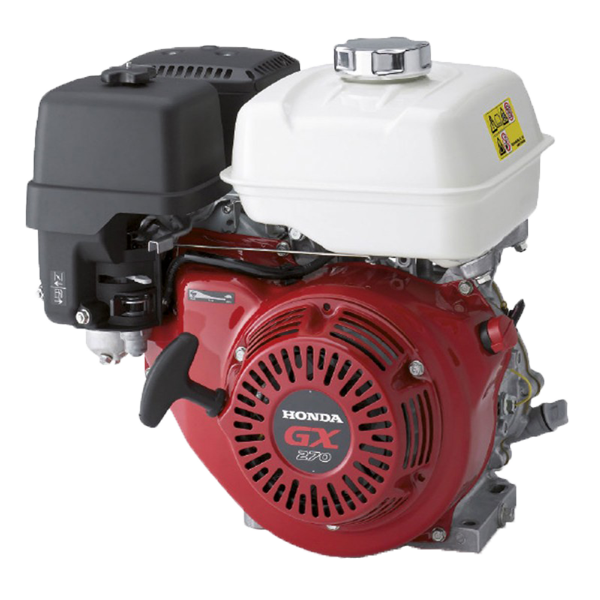
Honda GX270 engine 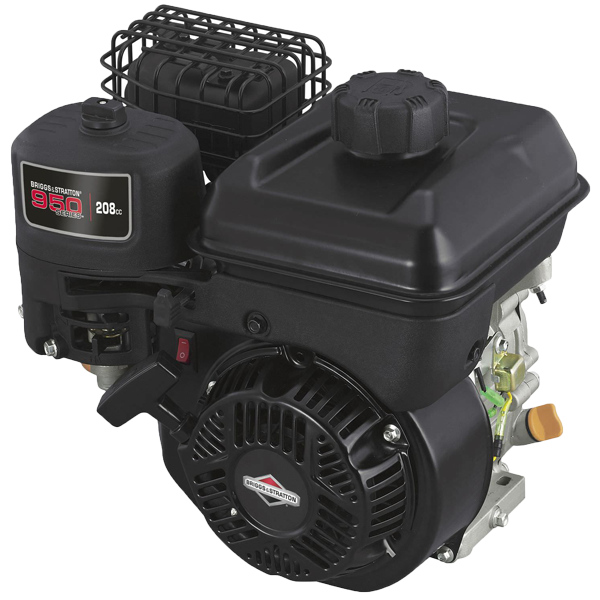
Briggs&Stratton 950 engine 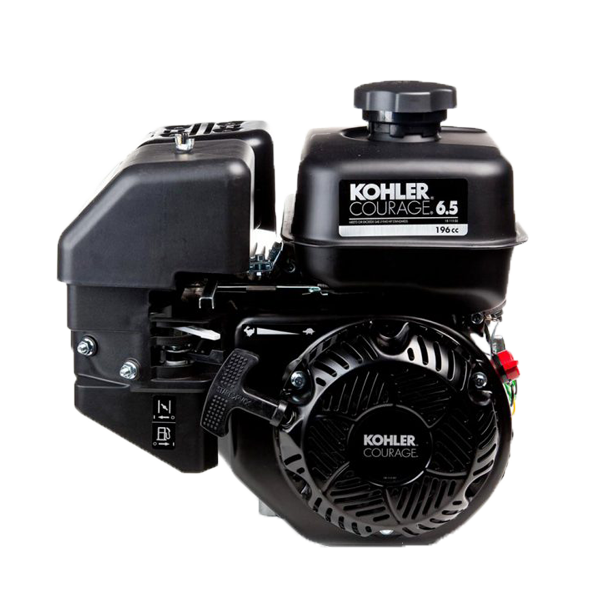
Kohler SH265 engine
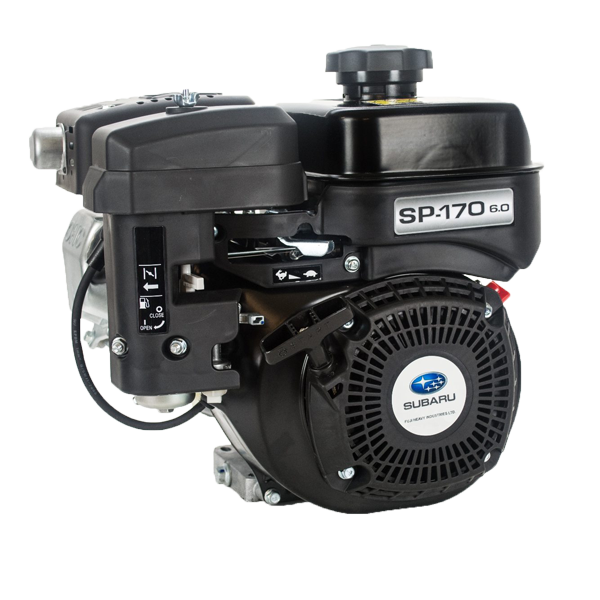
Subaru SP170 engine 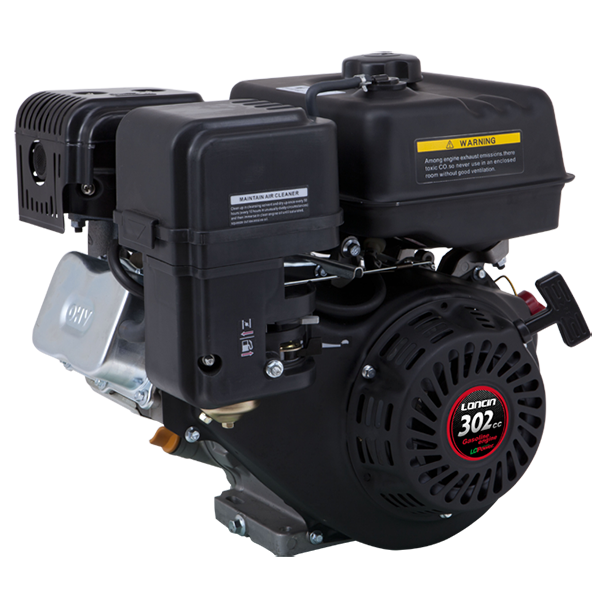
Loncin G300FA engine 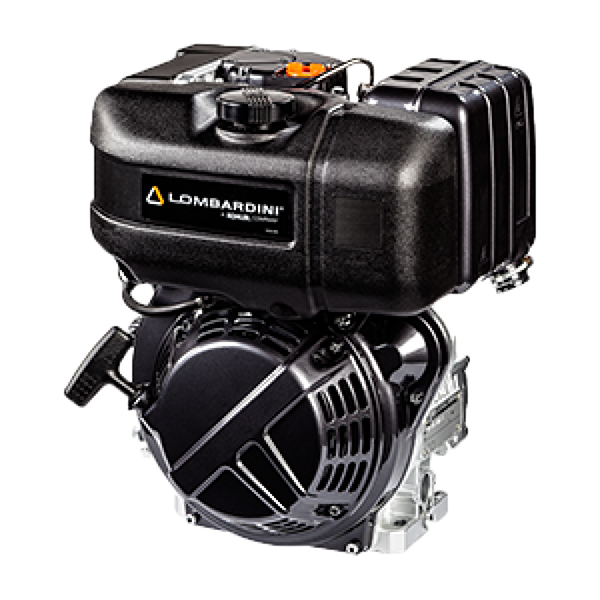
Lombardini 15LD350 engine
Are you looking for the absolute best garden tiller for intensive work and don’t know which one to pick?
Choose a diesel garden tiller with Lombardini engine and gear transmission in oil bath, you won’t be disappointed!
11. Garden tiller vs two-wheel tractor
Farmers use large tillers attached to tractors to work on large fields, while smaller fields such as vegetable patches, small gardens, etc. are worked with garden tillers or two-wheel tractors, depending on the task at hand.
Although these two types of machine may appear similar at first sight, the most evident difference is that the two-wheel tractor has two wheels (which generate its traction), whereas the garden tiller does not (and is therefore driven directly by the tiller).
Indeed, there are many differences between these two machines; let’s find out more by comparing the main features of one and the other:
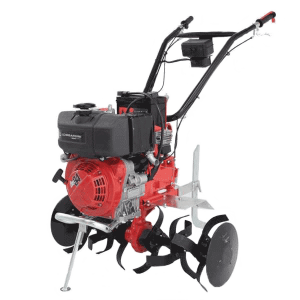
Garden tillers
- can work the soil in depth
- can work on very hard and poorly cultivated soils
- the tillers can reach a maximum width of 100 cm
- it is suitable for both small and large working extensions
- performs almost exclusively the milling function
- works in one direction only
- can be electric, battery-powered, petrol or diesel
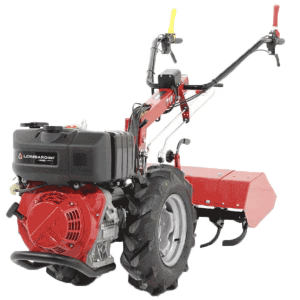
Two-wheel tractor
- works more on the surface and carries out a refining operation
- can only work on soft, already tilled soils
- the tillers can reach a maximum width of 80 cm
- is mainly suitable for vegetable patches, specific crops or within rows
- it can be multitool (by replacing the tiller with other accessories)
- it can be reversible and work in both directions
- it runs on petrol or diesel only
This guide has been specifically drawn up as a useful reference to help the user choose the best garden tiller according to his/her requirements.
If you have realised that what you need is not a garden tiller but a two-wheel tractor, we recommend that you check our purchasing guide for the best two-wheel tractor.
If instead you wish to find out more about the main differences between a garden tiller and a two-wheel tractor, we suggest you read the specific feature article.



